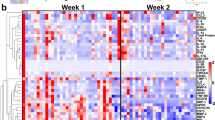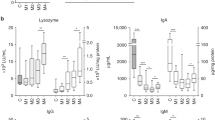Abstract
The presence of interleukin-12 (IL-12) in 39 samples of human milk was investigated using the enzyme-linked immunosorbent assay. IL-12 (>40 pg/mL) was detected in 24 of the 39 samples collected (1408 ± 2256 pg/mL, mean ± SD, n = 24). A range of concentrations of IL-12 was observed in colostrum, transitional, and mature milk, with an apparent decrease in the mean concentration over time postpartum.
Similar content being viewed by others
Main
Human milk contains a complex mixture of immunologically active components providing both specific and nonspecific defenses against infectious agents. Among the many bioactive substances detected in breast milk that have immunomodulatory potential are a number of peptide mediators known as cytokines. Proinflammatory cytokines such as TNF-α(1), IL-1β(2), IL-6(3), IL-8(4), and IFN-γ(5), as well as antiinflammatory cytokines, including transforming growth factor-β(6) and IL-10(7), are present in quantities likely to be physiologically significant. Cytokines in human milk may play an immunomodulatory role in the alimentary tract of the recipient infant and potentially affect development of the immune system.
IL-12 has not previously been detected in human milk. This cytokine has been shown to enhance lymphocyte-mediated cytotoxicity(8), T cell proliferation(9), and production of a number of other cytokines, including IFN-γ, TNF-α, granulocyte-macrophage colony-stimulating factor, monocyte-macrophage colony-stimulating factor, and IL-2, -3, and -8(10). IL-12 has also been shown to suppress the synthesis of IgE by B cells in the presence of T cells in vitro(11).
IFN-γ and mononuclear cells, both of which are present in human milk, are associated with the production of IL-12(12), leading us to attempt to determine whether IL-12 may also be present. We report the results of a cross-sectional study investigating the presence of IL-12 in human milk at three stages of lactation, using a specific enzyme-linked immunoassay.
METHODS
Subjects. A single breast milk sample was collected from 39 mothers (ages 18-37 y; parity, 1-5) of healthy term infants who were attending a research clinic at Flinders Medical Centre (FMC), Adelaide, Australia. Of these women, 31 (80%) had delivered vaginally, and 11 (29%) smoked cigarettes. Data relating to maternal atopic status (allergic rhinitis, asthma, dermatitis/eczema, or food allergy) and any illness or infection suffered by the mother during the week before sample collection were recorded. Of the 38 women from whom data were collected, 11 (28%) reported some form of illness or infection during the week preceding sample collection, and 24 (63%) reported some degree of atopic history. The study was approved by the Clinical Investigations (Ethics) Committee of FMC, and informed consent was obtained before enrollment.
Protocol. After manual expression into sterile polypropylene containers, milk samples (2-5 mL) were categorized according to stage of lactation: colostrum (≤6 d, n = 13), transitional (11-16 d, n = 13), or mature (40-46 d, n = 13). All samples were stored at 4°C and were processed within 2 h of collection. The samples were centrifuged at 690 × g for 20 min, and the aqueous phase was stored at -80°C until analysis.
Immunoassay. The IL-12 p70 heterodimer was measured in the aqueous phase of the milk by ELISA, using a p35/p70 primary antibody and p40/p70 detecting antibody combination at concentrations recommended by the manufacturer (Pharmingen, San Diego, CA). The minimum detectable level was 40 pg/mL. There was assumed to be no interference by the p40 IL-12 monomer or a range of other cytokines as reported by the manufacturer.
Data analysis. IL-12 levels obtained are expressed in pg/mL. Samples below the minimum detectable level were assigned a value of 20 pg/mL for statistical analysis. Associations between clinical data and log-transformed cytokine concentration values were examined by Spearman correlation using SPSS for Windows 6.0 (SPSS Inc., Chicago, IL).
RESULTS
IL-12 was detected in 24 of the 39 samples collected. The concentration of IL-12 in all samples with amounts above the minimum level of detection was 1408 ± 2256 pg/mL (mean ± SD; n = 24). The levels of IL-12 found in the aqueous phase of individual samples are shown in Table 1. The median concentration of IL-12 decreased from 310 pg/mL in the colostral samples to 176 pg/mL in the transitional milk samples and was below the minimum detectable concentration in the mature milk samples. No associations were found between maternal illness/infection or atopic profile and IL-12 concentration; however, the large number of samples below the level of detection may make statistical analysis inappropriate.
DISCUSSION
This is the first report of the presence of IL-12 in human milk. The concentration of IL-12 was found to be within our detection limits in 62% of samples tested. There was a broad scatter of values, regardless of time postpartum, as has been observed for other cytokines detected in human milk(1–7). The wide range of concentrations observed was not readily explained by stage of lactation or maternal clinical characteristics such as recent illness or atopic history.
The presence of IL-12 in the aqueous phase of human milk has previously been investigated with ELISA kits (R&D systems Minneapolis, MN)(13,14). However, IL-12 was not detected, which may reflect the use of antibodies of differing specificity for the antigen of interest. The source of IL-12 in human milk is unknown. However, neutrophils, lymphocytes, and macrophages are found in milk during the first few months of lactation(15), and one or more of these cell types have the potential to secrete IL-12.
The presence of IL-12 in human milk may have broad implications for the recipient infant. IL-12 can stimulate the growth and development of T lymphocytes and natural killer cells(8,9) and, like the classic T helper 1 (Th1) cytokines, IL-2, and IFN-γ(16), IL-12 is involved in the control of Th1/Th2 differentiation(17). The in utero environment of human infants during pregnancy is predominantly regulated by Th2-type cells(18). A supply of exogenous IL-12 from the milk of a breast-feeding mother may assist in addressing the balance between predisposed Th2-type responses and the Th1-type cytokine-driven cell-mediated response.
Abbreviations
- IL-12:
-
interleukin-12
- IFN-γ:
-
interferon-γ
- ELISA:
-
enzyme-linked immunosorbent assay
- TNF-α:
-
tumor necrosis factor-α
- Th:
-
T helper
References
Rudloff HE, Schmalstieg FC Jr, Mushtaha AA, Palkowetz KH, Liu SK, Goldman AS 1992 Tumor necrosis factor-alpha in human milk. Pediatr Res 31: 29–33.
Munoz C, Endres S, van der Meer J, Schlesinger L, Arevalo M, Dinarello C 1990 Interleukin-1 beta in human colostrum. Res Immunol 141: 505–513.
Rudloff HE, Schmalstieg FC Jr, Palkowetz KH, Paszkiewicz EJ, Goldman AS 1993 Interleukin-6 in human milk. J Reprod Immunol 23: 13–20.
Palkowetz KH, Royer CL, Garofalo R, Rudloff HE, Schmalstieg FC Jr, Goldman AS 1994 Production of interleukin-6 and interleukin-8 by human mammary gland epithelial cells. J Reprod Immunol 26: 57–64.
Bocci V, von Bremen K, Corradeschi F, Franchi F, Luzzi E, Paulesu L 1993 Presence of interferon-gamma and interleukin-6 in colostrum of normal women. Lymphokine Cytokine Res 12: 21–24.
Saito S, Yoshida M, Ichijo M, Ishizaka S, Tsujii T 1993 Transforming growth factor-beta (TGF-beta) in human milk. Clin Exp Immunol 94: 220–224.
Garofalo R, Chheda S, Mei F, Palkowetz KH, Rudloff HE, Schmalstieg FC, Rassin DK, Goldman AS 1995 Interleukin-10 in human milk. Pediatr Res 37: 444–449.
Robertson MJ, Soiffer RJ, Wolf SF, Manley TJ, Donahue C, Young D, Herrmann SH, Ritz J 1992 Response of human natural killer (NK) cells to NK cell stimulatory factor (NKSF): cytolytic activity and proliferation of NK cells are differentially regulated by NKSF. J Exp Med 175: 779–788.
Bertagnolli MM, Lin BY, Young D, Herrmann SH 1992 IL-12 augments antigen-dependent proliferation of activated T lymphocytes. J Immunol 149: 3778–3783.
Aste-Amezaga M, D'Andrea A, Kubin M, Trinchieri G 1994 Cooperation of natural killer cell stimulatory factor/interleukin-12 with other stimuli in the induction of cytokines and cytotoxic cell-associated molecules in human T and NK cells. Cell Immunol 156: 480–492.
Kiniwa M, Gately M, Gubler U, Chizzonite R, Fargeas C, Delespesse G 1992 Recombinant interleukin-12 suppresses the synthesis of immunoglobulin E by interleukin-4 stimulated human lymphocytes. J Clin Invest 90: 262–266.
Hayes MP, Wang J, Norcross MA 1995 Regulation of interleukin-12 expression in human monocytes: selective priming by interferon-gamma of lipopolysaccharide-inducible p35 and p40 genes. Blood 86: 646–650.
Srivastava MD, Srivastava A, Brouhard B, Saneto R, Groh-Wargo S, Kubit J 1996 Cytokines in human milk. Res Commun Mol Pathol Pharmacol 93: 263–287.
Sone S, Tsutsumi H, Takeuchi R, Matsuda K, Imai S, Ogra PL, Chiba S 1997 Enhanced cytokine production by milk macrophages following infection with respiratory syncytial virus. J Leukoc Biol 61: 630–636.
Smith CW, Goldman AS 1968 The cells of human colostrum. I. In vitro studies of morphology and functions. Pediatr Res 2: 103–109.
Mosmann TR, Cherwinski H, Bond MW, Giedlin MA, Coffman RL 1986 Two types of murine helper T cell clone. I. Definition according to profiles of lymphokine activities and secreted proteins. J Immunol 136: 2348–2357.
Manetti R, Parronchi P, Giudizi MG, Piccinni MP, Maggi E, Trinchieri G, Romagnani S 1993 Natural killer cell stimulatory factor (interleukin 12 [IL-12]) induces T helper type 1 (Th1)-specific immune responses and inhibits the development of IL-4-producing Th cells. J Exp Med 177: 1199–1204.
Marzi M, Vigano A, Trabattoni D, Villa ML, Salvaggio A, Clerici E, Clerici M 1996 Characterization of type 1 and type 2 cytokine production profile in physiologic and pathologic human pregnancy. Clin Exp Immunol 106: 127–133.
Acknowledgements
The authors thank Dr. Prue Hart, who kindly provided antibodies to IL-12. We also thank Jane Armstrong and Jenny Osmond for their assistance in enrolling mothers and collecting milk samples.
Author information
Authors and Affiliations
Rights and permissions
About this article
Cite this article
Bryan, DL., Hawkes, J. & Gibson, R. Interleukin-12 in Human Milk. Pediatr Res 45, 858–859 (1999). https://doi.org/10.1203/00006450-199906000-00013
Received:
Accepted:
Issue Date:
DOI: https://doi.org/10.1203/00006450-199906000-00013
This article is cited by
-
Pre- and perinatal characteristics and breast milk immune markers
Pediatric Research (2013)
-
Maternal immune markers in serum during gestation and in breast milk and the risk of asthma-like symptoms at ages 6 and 12 months: a longitudinal study
Allergy, Asthma & Clinical Immunology (2012)
-
Interleukin-10 and -12 in human milk at 3 stages of lactation: A longitudinal study
Advances in Therapy (2007)
-
Polyunsaturated fatty acids and T‐cell function: Implications for the neonate
Lipids (2001)



